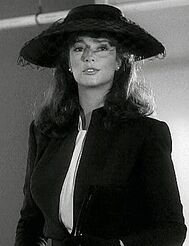Mounoir
Mounoir (Gylic transcription: Munoá) is a Gylian film genre, analogous to neo-noir in other countries. It is characterised by a combination of film noir aesthetics with a cozy mystery or comedy mystery storytelling.
The subgenre emerged during the wretched decade, and has become an established niche in Gylian cinema.
Terminology
The term comes from the French mou, meaning "soft", and noir, meaning "black". It can be loosely translated as "soft noir".
Surface jokingly explained the term's adoption for two reasons: "nobody wanted to call their work films gris", and "mounoir sounds almost like boudoir".
Background
Film noir had never garnered much attention in Gylias. Its heyday in countries like Acrea and Delkora coincided with the Liberation War in the Free Territories, an environment especially unsuited for "morbid drama". Jaipriya Jandhyala commented that one of the few noir films to achieve exposure in this period was Livsforsikring (1944), but Free Territories audiences mainly focused on Brynhild Svendsen's performance and the famous final scene set in the Free Territories.
Thus, for a long time film noir was obscure in Gylias, and one of the few areas where it could attract some interest was in film schools. Gradually, a small group of film school students formed who would form the first wave of mounoir directors, cinematographers, and editors.
The Quenminese film Blade Runner (1982) was cited as an inspiration by several mounoir creators in the way it merged the aesthetics of film noir with a science fiction setting, and thus encouraged them to pursue similar fusions.
Characteristics
Radix lists the fundamental characteristics of mounoir films as "film noir visuals, film school sensibilities, comfy atmosphere, and contempt for the right-wing paranoia of traditional noir and hardboiled fiction".
While mounoir films ape the visual aspects of film noir, they reject or explicitly oppose its thematic elements. Mounoir plots tend towards cozy mystery or comedy mystery. However, they are also separated from cozy mysteries by their use of explicit profanity and sexuality. Cultural commentator Hanako Fukui writes that mounoir films thus reflect Gylian sensibilities, where "sexuality is exalted, violence is scorned, and one can tell a good adversary from a horrible enemy".
The clearest example of mounoir's reinterpretation of established noir elements is its treatment of femme fatale characters. In contrast to film noir's use of femmes fatales as secondary characters with mysterious motives who lead main characters into ruin, mounoir films instead put femmes fatales in the protagonist role — replacing that of the detective — and gave them an explicitly "wicked" interpretation, emphasising their seductiveness and resourcefulness as admirable traits.
One of the genre's celebrated actresses, Leonora Weeks, even provided an archetype dubbed the "good femme fatale", whose seductive aspects are melded with an easygoing and friendly personality, and an explicitly "good" moral alignment.
The distinctive "film school sensibility" of the genre is manifested in its postmodernist qualities, mainly its use of self-referential humour, homages to and parodies of other works, and breaking the fourth wall.
Mounoir was strongly shaped by the wretched decade, and was discussed by Keie Nanei in Antichronos as a genre that employed the strategy of "using the past to comment on the present". Many mounoir films of the 1980s are politically charged, attacking the crises of the decade or exploring the causes and manifestations of post-revolutionary political stagnation. They are also strongly leftist in tone, ranging from anarchist to socialist, but championing several common values, such as the importance of decentralisation, anti-authoritarianism, trade unionism, and opposition to bigotry.
History
The first mounoir film, Gylida, was released in 1982. It is credited with kickstarting the whole subgenre.
The team of director Tede Razeş and actress Leonora Weeks proceeded to make several more seminal mounoir films, taking advantage of larger budgets. These films allowed Leonora to be paired with suitably heavyweight co-stars: Reda Kazan in Softboiled (1984), fellow mounoir mainstay Jen Wood in Night's Edge (1985), and Carla Miló in Fraganza (1987).
The most associated actresses with the genre were Leonora Weeks and Jen Wood, both of whom shared key traits described by Gylias Review: they possessed a "fundamental niceness and joviality" that prevented them from being credible femmes fatales, and thus added a playful aspect to their displays of cunning sensuality and androgynous appeal.
The genre's peak largely coincided with the wretched decade, and its slow dénouement under the Filomena Pinheiro government. The "first wave" of mounoir films is conventionally dated to end in 1988–1989, and subsequent decades saw its best-known figures update the style and evolve in different directions.
While mounoir is largely a Gylian-specific genre, there were some notable international collaborations with Delkoran and Megelanese filmmakers, whose countries shared experiences of political or social turbulence during the 1980s. One famous collaboration was the Gylian–Delkoran cartoon Miss Mystery in the 1990s.
Notable works influenced by mounoir include the literary work of Esua Nadel and The Case of the Facts, Le recueil des faits improbables de Ryōko Yakushiji, and Madame Mirage. Quenminese author Đổng Mộng Thanh credited the genre with helping attract an audience to the Rainbow Mistress series starring Tống Ẩu Huệ.

